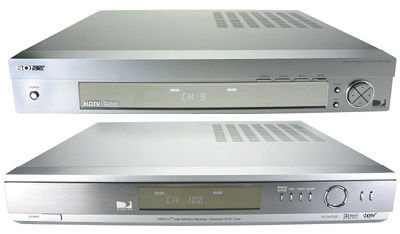Sony SAT-HD200 & Zenith HD-SAT520 DirecTV/digital television receivers

Zenith invented 8-VSB, the transmission system for digital television, and every DTV tuner is built around an 8-VSB chip licensed from Zenith, a wholly owned subsidiary of South Korea's LG Electronics. Zenith's first HDTV receiver was a professional product, the IQADTV1W, which cost $5995 and was by far the best digital receiver of 1999—as it ought to have been, considering the price. Zenith's second-generation receiver, last year's DTV 1080, was a fine product whose performance didn't quite measure up to that of the top-of-the-line products from Sony, Panasonic, and Mitsubishi/Toshiba/Hughes (the latter three were all built on the same Hughes chassis).
In & Out
It's not uncommon for one company that doesn't want to build a product from scratch to buy a second company's product, replace the faceplate, tweak the feature set, add its own remote, and sell it under its own brand name. Both of these tuners were made in Korea by Zenith/LG Electronics, and are nearly identical. The chassis, rear panel, jacks, and onscreen menus are all the same; a few slight differences, including the front panels, account for the slightly different external dimensions and weights. Both have the same six front-panel buttons—Display format, Information, Menu, Guide, Select, and Exit—placed and labeled a bit differently. A peek inside shows that the circuitry and internal layout are as close as it is possible to determine without schematics and parts lists, though two large integrated circuits from LGE are visible in each.
Companies don't like to discuss these arrangements, but it's easy to see why Sony might have made this choice: DTV receiver boxes are not big sellers. In fact, I've been told by one manufacturer that they lose money on the product. Sony, a full-service company, must have a DTV box in its lineup, but they may have decided they would rather invest their R&D dollars in more important and profitable products.
Sony's suggested retail price for the SAT-HD200 is $200 higher than Zenith's price for the HD-SAT520, but Sony says the actual sale price in most stores will be $799, with possible discounts below that. However you count it, however, the Sony will be more expensive.

Both receivers come in sleek silver boxes of brushed metal. Each has a big front-panel display, something offered by no other receiver of this sort that I've seen. Some may view such a display as redundant, but I've found it quite convenient. It tells you what the box is doing—for example, which display format is in use—without your having to call up an onscreen display.
On the back of each receiver is a full suite of outputs, including a DVI digital output for digital TVs so equipped. Last year, DirecTV chose DVI as the output of choice for its receivers. DVI's greatest benefit is that it's cheap to install, unlike IEEE 1394, which can add a lot to a product's cost. The liability is that you can't record a DVI video signal; its data rate is far too high for any foreseeable consumer recording format. (Some manufacturers tout DVI as an uncompressed format. It does carry a denser datastream than an analog or IEEE 1394 link, but the extra bits do not enhance the quality in any way. A high-definition signal routed via DVI has no more resolution than that which came over the air/cable/satellite carrier.) The Sony receiver includes a DVI cable said to cost about $20. The Zenith does not.
I've been reviewing DTV receivers for more than four years now, and I've never seen a perfect one—a box that combines topnotch reception (a highly variable capability) with a complete feature list. Samsung's attempt at this, the SIR-TS160 high-definition and DirecTV tuner, reviewed in the February 2003 issue, offered a near-perfect feature set but mediocre performance as an over-the-air digital receiver.
The SAT-HD200 remedies the two most glaring weaknesses of Sony's earlier product: Like all current DirecTV receivers I've seen, it has no fan, which means it's perfectly quiet. And it not only has aspect-ratio control, it has the best iteration of the feature I've seen in a receiver box: eight different settings for viewing 4:3 material on a 16:9 screen, or vice versa.
Both receivers under review here output any analog or digital signal you want: 480i, 480p, 720p, or 1080i. (The older Sony box didn't support 720p, the display format for ABC's high-definition programming.) In both products, the output format is selected on the front panel or from the remote. This is an improvement for Zenith—you had to reach around behind their older receiver and pull a switch to change output formats. The Sony version offers several settings that allow the receiver to convert any incoming signal to a specified output format, a bit of flexibility the Zenith HD-SAT520 doesn't offer. That's probably the biggest difference between the two receivers—though the older Sony HD100 offers the same feature, and I've never found cause to use it. Others, with different equipment configurations, may find it useful.





























































